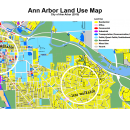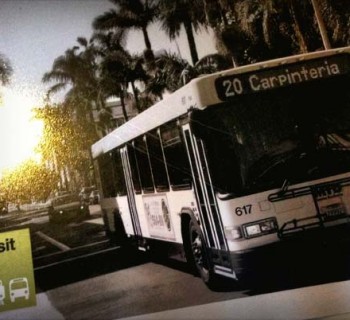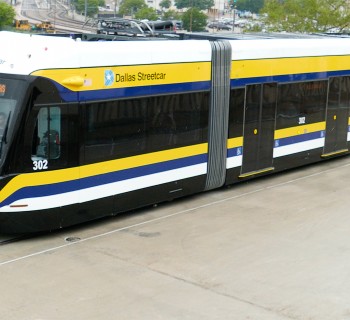Created by the Michigan legislature in 2012, the Regional Transit Authority (RTA) regional authority is charged with coordinating public transit in Macomb, Oakland, Washtenaw and Wayne Counties and establishing rapid transit in the region. It currently oversees the AAATA, the Detroit Department of Transportation, SMART and Detroit’s People Mover. The RTA will be also responsible for supervising the M-1 Rail service once it gets rolling and is examining possible involvement with an Ann Arbor-Detroit commuter rail line proposed by the Southeast Michigan Council of Governments.
Right now, the RTA has several big projects on its plate: developing a master transit plan for the region, realizing Bus Rapid Transit on Woodward Avenue and determining the best rapid transit options for the Gratiot and Michigan Avenue corridors. On top of that, it's also looking into establishing an airport shuttle service for the region.
It’s been awhile since Mode Shift has looked at the RTA, so we decided to take a closer look at each of these projects here.
Regional Master Plan
In May of last year, the agency kicked off an effort to develop a unified multi-modal transit vision for the region, which it’s calling the BEST (Building Equitable Sustainable Transit) plan.
Its goal is to figure out the best mix of services for the region. This will likely include creating new rapid transit services along major corridors and establishing better coordination between existing providers. The plan also involves coming up with a viable funding strategy to realize its vision.
“Through the master planning process we are trying to coordinate our current transit system and to connect communities across our region so that people have true mobility options,” RTA Communications Manager Travis Gonyou tells Mode Shift. “This would help many residents get from their home to their jobs, to doctor's appointments, increase access to healthy foods, connect key centers of entertainment and culture, as well as facilitate development across southeast Michigan.”
In September and October, the RTA held a series of regional community meetings to collect input from residents and other stakeholders to help them draw up the BEST plan. The authority is currently using that data to refine their plan and hopes to issue a draft this spring. After that there will be a second round of outreach to get further public feedback. From there, it will be revised and submitted to the agency’s board for approval. Ultimately citizens will decide what happens with the BEST plan, as the agency is expected put a transit funding proposal, which would pay for the RTA and its bus rapid transit efforts, before voters this fall.
Woodward, Gratiot and Michigan Corridor Studies
Last autumn, The RTA also held a series of community events to gather feedback on the future of the Gratiot and Michigan Avenue corridors.
Figuring out how to improve transportation along these thoroughfares, as well as Woodward Avenue, is part of the agency’s founding mission. The authority’s board has already approved a Locally Preferred Alternative Plan to create a bus rapid transit system on Woodward between Detroit and Pontiac, which is now undergoing a federal environmental review.
A Locally Preferred Alternative (LPA) is the option the local agency supervising a transit project recommends after conducting an analysis and consulting with local stakeholders. After an LPA is selected, it is submitted to the federal government for review.
What will happen along Gratiot and Michigan still remains to be determined, but the RTA took the first steps towards figuring that out with a round of information gathering meetings with local residents and stakeholders in September and October.
The 23-mile Gratiot corridor connects Detroit and Mt. Clemens. Bus ridership along the avenue is some of the most bustling in the region, averaging roughly 12,000 riders a day. The Michigan Avenue route being studied covers a 40-mile stretch between Detroit and Ann Arbor that offers access to some of Southeast Michigan's most significant job centers, educational institutions and cultural destinations, as well as Detroit Metro Airport.
Planning for the Gratiot and Michigan studies began this spring. The RTA expects to have a LPA plan completed for both corridors by March of this year.
Airport Shuttle Service
This summer, the RTA also announced its intention to establish a regional airport shuttle service. Under its plan, bus service would initially run between Detroit Metropolitan Airport and downtown Detroit, eventually expanding to cover Wayne, Washtenaw and Macomb Counties.
The agency estimates the annual price of the regional bus service at $6.5 million. It’s already secured a $1.5 million grant to get the bus shuttle started and hopes to sustain that service and other projects with money from its proposed funding ballot measure.
In November, though, the RTA announced it would be taking a step back from the project to collect more feedback from potential bidders.
“After receiving no bids in the first round, we have went back to add some clarifications in the proposal,” says Gonyou. “We are still actively pursuing an airport service for the region.”
Moving Forward
The Southeast Michigan Regional Transit Authority certainly had a rough time getting off the ground over the past few years. After a prospective chief executive reneged on plans to head up the agency in 2014, it almost looked as though the RTA might sputter out before it ever got going. The organization’s board eventually chose Michael Ford, a former Ann Arbor Area Transit Authority (AAATA) CEO, to lead up things, however, and under his watchful eye the RTA now appears to be moving ahead at a good clip.










